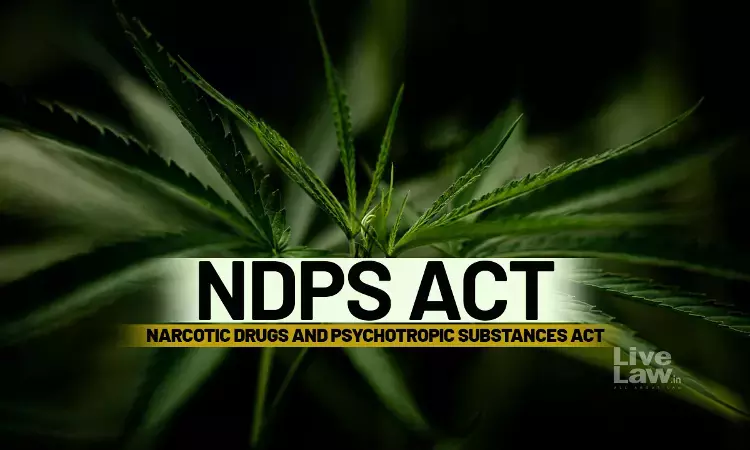“Ganja” Includes Only Flowering Or Fruiting Top Of Cannabis Plant, Not Stem And Stalk: Madras High Court
Upasana Sajeev
30 Oct 2025 4:56 PM IST

The Madras High Court has held that the definition of Ganja does not include the stem and stalk, but only includes the flowering or fruiting top.
Justice KK Ramakrishnan emphasised that when a contraband is accompanied by stems and seeds, the weight of the flowering or fruiting top alone is to be considered for ascertaining the commercial quantity.
“At the cost of repetition, this Court holds that if the contraband is accompanied by luxuriant leaves, stem and stalk, with the flowering or fruiting tops, the weight of flowering tops or fruiting tops alone to be considered. If the contraband is accompanied by small leaves and seeds namely, the vegetative tops, then the whole weight can be considered,” the court said.
It may be noted that as per Section 2(iii)(b) of the Narcotics and Psychotropic Substances Act Ganja has been defined as “ganja, that is, the flowering or fruiting tops of the cannabis plant (excluding the seeds and leaves when not accompanied by the tops), by whatever name they may be known or designated”.
The court noted that when the Act itself has excluded seeds and leaves, there is a burden on the prosecution to prove that the contraband seized comes under the definition of Ganja, considering the rigidity of the procedure.
“When the Act itself excludes seeds and leaves of the cannabis plant in certain circumstances, and does not include stem and stalk, the burden on the prosecution to prove that their case comes under the definition is heavy, considering the harshness of the punishment and the rigidity of the procedure in conducting trial,” the court said.
The court noted that the “comma” used in the definition would clearly show that the definition includes only the flowering or the fruiting top and the seeds, and small leaves would be included only when they are accompanied by the flowering or the fruiting tops.
“The “Comma” and the words “that is” followed by a comma is a clear indicator to mean that the flowering or fruiting tops of the cannabis plant alone come under the definition of ganja and in some cases, seeds and small leaves otherwise called “vegetative tops” as discussed above would be included only when they are accompanied by the flowering or fruiting tops. But, there is total exclusion of compound leaves namely, luxuriant leaves, stalk and stem,” the court said.
The court was hearing a batch of appeals against conviction under the Narcotics and Psychotropic Substances Act. In all the cases, the appellants had argued that they were convicted for possessing a commercial quantity of Ganja without proof of the constituents of the definition of Ganja as per Section 2(ii) of the Act. The State, in all the cases, argued that the recovered Ganja satisfied the constituents of definition of Ganja.
The court noted that since the Act provided stringent punishment for possessing commercial quantities of Ganja, without bail, it was the duty of the court to see that all the ingredients specified in the provision was satisfied.
The court reiterated that if the recovered Ganja is accompanied with leaves and seeds, it is the duty of the investigating agency to measure the offending materials separately without including the stem and stalk. The court highlighted that this compliance was legally required to be followed in cases where the recovered contraband was in borderline, weighting 21 and 25 kgs. The court added that in cases where the weight of contraband seized was more than 25 kg, there wouldn't be much significant change in the weight of the contraband.
The court noted that in the present case, there was ambiguity on whether the weight of the seized Ganja excluded the weight of the bag, stalk, stem, luxuriant leaves or only the flowering or fruiting tops of the cannabis plant. Noting such ambiguity and the fact that the appellants were confined to prison without bail since the date of arrest, the court was inclined to allow the appeals.
The court further remarked that allowing such illegality to perpetuate at the cost of confinement in prison without bail would be against the fundamental right of the accused to a fair trial. The court added that when such illegality is brought to the court's notice, it is the duty of the court to obliterate such illegality by bringing in remedial measures and not allowing such illegality to continue.
Counsel for Appellant: Mr. A. Robinson, Mr.T.A. Ebenezer, Mr.J.Selvam, Mr.T.Balachandran, Mr.M.Pitchai Muthu, Mr.G.Karuppasamy Pandian, Mr.K.Jeyaraman, Mr.Karupasamy Pandian for Mr.NA.Manimaran, Mr.S.Kanagaraj for Mr.R.Alagumani & Mrs.G.Prabhahari, Legal Aid Counsel, Mr.K.S.Durai Pandian, Mr.S.Ramsundarvijayraj, Mr.K.Samidurai, Mr.R.Alagumani, Mr.V.K.Sathiamurthy, Mr.K.Madhu, Mr. M. Jegadeesh Pandian
Counsel for Petitioner: Mr. R. Meenakshi Sundaram Additional Public Prosecutor
Case Title: Ganesan v. The State
Citation: 2025 LiveLaw (Mad) 387
Case No: Crl.A.(MD).No.212 of 2020


